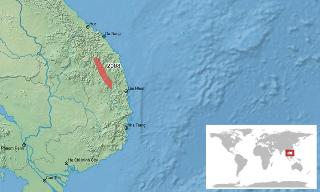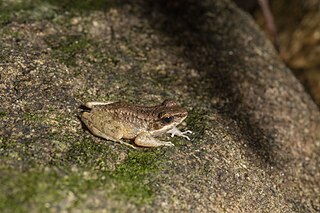
Odorrana aureola, also known as the Phu Luang cliff frog or gold-flanked odorous frog, is a true frog species from northeastern Thailand. The specific name aureola is Latin and means ornamented with gold, in reference to the characteristic yellow markings on the limbs and flanks of this frog. It is notable for its ability to change color between green and brown, according to the surroundings.
Ecnomiohyla thysanota, also known as Cerro Mali treefrog, is a species of frog in the family Hylidae. It is endemic to Panama where it is known from its type locality, Cerro Malí in eastern Serranía de Darién, near the border to Colombia, where it might also occur. This arboreal species is only known from a single specimen, the holotype.
Pristimantis modipeplus is a species of frog in the family Strabomantidae. It is endemic to the Andes of central Ecuador in Chimborazo, Pichincha, and Tungurahua Provinces. Common name Urbina robber frog has been proposed for it.
Pristimantis polemistes is a species of frogs in the family Strabomantidae. It is endemic to Colombia and only known from the vicinity of its type locality in Urrao, Antioquia Department, on the western flank of the Cordillera Occidental. The specific name polemistes is Greek for "warrior" and refers to the insurgents that operated in the area of the type locality.

Leptobrachella tuberosa, also known as the granular toad, is a species of frog in the family Megophryidae. As currently known, it is endemic to the Central Highlands of Vietnam in Gia Lai, Quảng Nam, and Thừa Thiên–Huế Provinces. Its true range is probably wider as suitable habitat extends further north and east, reaching northeastern Cambodia and southeastern Laos. The specific name tuberosa is derived from the Latin tuberosus, meaning "full of protuberances".
Amolops nepalicus is a species of frog in the family Ranidae. It is endemic to Nepal and is only known from two localities in the Sankhuwasabha District. Common names Nepal sucker frog and Nepal cascade frog have been proposed for it.
Odorrana absita is a species of frog in the family Ranidae. It is found in southern Laos and central Vietnam. It was originally described in genus Huia. Its type locality is Xe Sap National Biodiversity Conservation Area in southern Laos.
Amolops mengyangensis is a species of frog in the family Ranidae. It is known with certainty only from its type locality, the eponymous Mengyang in Xishuangbanna Dai Autonomous Prefecture, southern Yunnan province of China. However, if Amolops daorum is its junior synonym, distribution of Amolops mengyangensis would be considerably wider, including the vicinity of Sa Pa in northern Vietnam near the Chinese border, Hong Kong, and Houaphanh Province in eastern Laos, and presumably also including the intervening areas.
Odorrana mawphlangensis is a species of frog in the family Ranidae. It is endemic to northeastern India, although its range might extend into Bhutan and Nepal. The type locality is Mawphlang sacred forest in the Khasi Hills. Common names Mawphlang wart frog, Mawphlang frog, Mawphlang odorous frog, and hill stream frog have been coined for it.

The Amami tip-nosed frog is a species of frog in the family Ranidae. It is endemic to the Amami Islands, a part of the Ryukyu Islands, Japan. Specifically, it is known from the islands of Amamioshima and Tokunoshima.
The Tonkin frog is a species of frogs in the family Ranidae. It is found in northern Vietnam and in adjacent southern China. The specific name is derived from Bac Bo, the Vietnamese name for northern Vietnam, as the species was first described from there.
Odorrana banaorum is a species of frog in the family Ranidae that is known from Vietnam and Cambodia.
Amolops daorum is a species of frog in the family Ranidae. It is known from its type locality in the vicinity of Sa Pa in northern Vietnam near the Chinese border, Hong Kong, and Houaphanh Province in eastern Laos; presumably it also occurs the intervening areas. The Hong Kong record is considered suspicious, however.
Odorrana jingdongensis is a species of frogs in the family Ranidae. It is known from southern China and northern Vietnam, though it quite likely also occurs in the adjacent areas in Laos and in Myanmar. Its name refers to its type locality, Jingdong Yi Autonomous County in Yunnan. Common name Jingdong frog has been coined for it.
Odorrana junlianensis, also known as the Junlian odorous frog, is a species of frogs in the family Ranidae. It is found in southern China and in the northernmost Laos and Vietnam. Its type locality is the eponymous Junlian County in Sichuan.
Odorrana leporipes is a species of frog in the family Ranidae. It is endemic to Guangdong province of China and only known from its type locality, "Lung Tao Shan" in northern Guangdong. It is only known from the original species description; the type series is presumed lost and the photographs of the holotype are now the iconotype.
Odorrana morafkai is a species of frogs in the family Ranidae. It is found in eastern Cambodia, southern Laos, and central Vietnam. This frog is highly unusual because it turns from its daytime green color to brown at night.
Odorrana orba is a species of frog in the family Ranidae. It is found in southeastern Laos and central Vietnam. The specific name orba is Latin for "orphan", referring to the fact that this species was—at the time of species description—known in Vietnam only from a single juvenile.
Odorrana supranarina is a species of frog in the family Ranidae. It is endemic to Ryukyu Archipelago, Japan, and is known from the islands of Ishigaki and Iriomote, both in the Yaeyama Group. The specific name supranarina refers to the large size of this species —at the time of the species description, it was the largest member of the so-called Rana narina complex. Common name greater tip-nosed frog has been coined for it.

Odorrana utsunomiyaorum is a species of frog in the family Ranidae. It is endemic to Ryukyu Archipelago, Japan, and is known from the islands of Ishigaki and Iriomote, both in the Yaeyama Group. The specific name utsunomiyaorum honours Taeko and Yasuaki Utsunomiya for their contributions to clarifying the amphibian fauna of the Yaeyama Group.





